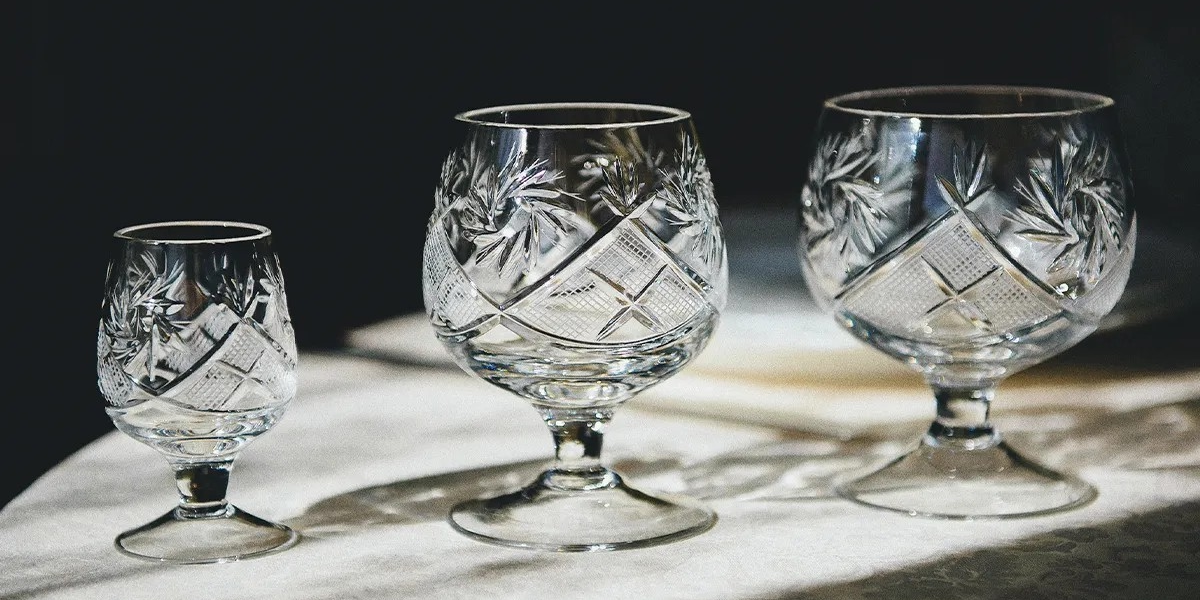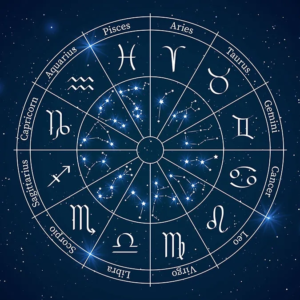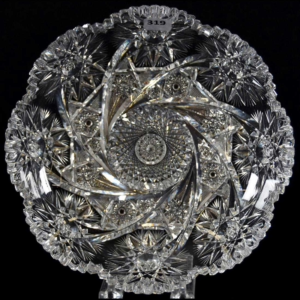Crystal Glass
Definitions and Overview
Crystal glass, also known as lead-crystalline glass, is a glass material that adds lead oxide and other substances to the glass composition, so that it has a crystal-like appearance and some properties. It is not a real crystal (the main component of crystal is silica and crystal structure), but because of its high transparency, gloss and beautiful appearance, it is often used to make high-end tableware, decorations and handicrafts, etc., and is widely used in the field of life and art.

Ingredient characteristics:
- Main ingredient: The basic ingredient is silicon dioxide (SiO₂), which, like ordinary glass, constitutes the main network structure of glass. But the key difference from ordinary glass is that crystal glass is added with a certain amount of lead oxide (PbO), usually in the range of 10% – 30%, depending on the product standard and use. In addition, it may contain small amounts of other oxides, such as potassium oxide (K₂O), sodium oxide (Na₂O), etc., which are used to adjust the melting temperature, viscosity and other process properties of the glass.
- The role of lead oxide:
- Improve transparency: Lead oxide can make the structure of the glass more dense and reduce the scattering of light in it, thereby greatly improving the transparency of the glass, making the finished products look crystal clear, very close to the transparent texture of natural crystal. For example, high-quality crystal glass tableware can see objects very clearly through it, as if there is no glass.
- Enhanced refractive index: With the addition of lead oxide, the refractive index of glass will be significantly improved, generally reaching about 1.54 – 1.70 (the refractive index of ordinary glass is usually around 1.4 – 1.5). The higher refractive index makes crystal glass products show a stronger refraction and reflection effect under light irradiation, and looks dazzling, with good luster and visual beauty, which is also one of the reasons why it is often used to make high-end decorations.
- Improve machinability: make the glass have better fluidity and plasticity at high temperatures, facilitate blowing, cutting, engraving and other fine processing technology, and can make products with complex shapes and exquisite craftsmanship, like some exquisite crystal glass ornaments, with delicate pattern carving, which is the use of its good machinability.
classify
- Classification by lead content:
- All-lead crystal glass: the lead oxide content is high, generally 24% and above, this kind of crystal glass has the best optical performance and texture, and is often used to make high-end wine utensils, tableware and artworks, etc., is a representative of high quality, and the price is relatively expensive. For example, some famous brands of crystal glass wine glasses, in order to pursue the ultimate visual effect and quality, will be made of all-lead crystal glass.
- Semi-lead crystal glass: the lead oxide content is between 10% – 24%, its performance and appearance are between all-lead crystal glass and ordinary glass, the cost is slightly lower than that of all-lead crystal glass, and the application range is also wider, which can be used to make some glass products with a slight sense of quality for daily use, such as decorative vases, candle holders, etc.
- Lead-free crystal glass: does not contain lead oxide components, but uses other substances such as barium oxide (BaO), zinc oxide (ZnO) and other substances to replace lead oxide, which plays a similar role in improving glass properties. This kind of crystal glass is mainly for environmental protection and other factors (because lead is potentially harmful to human health and the environment), and is more widely used in some product fields with high safety requirements, such as children’s tableware, ordinary household glass products, etc., although it may be slightly inferior to lead-containing crystal glass in terms of optical properties, but it still has good transparency and aesthetics.
- Classified by manufacturing process:
- Blown crystal glass: through the blowing process, the molten crystal glass liquid is blown into various shapes with a special blowpipe, like the common blown crystal glass vase, lampshade, etc., during the blowing process, it can be shaped according to the craftsman’s skills to shape a unique shape and line, often with a strong sense of artistic beauty and uniqueness.
- Pressed crystal glass: the use of molds to press the molten glass to make it shaped, this process has relatively high production efficiency, suitable for mass production of more regular and uniform products, such as some pressed crystal glass plates, bowls and other tableware, can ensure the consistency of product specifications.
- Cutting crystal glass: first make the basic shape of glass products, and then use cutting tools, according to the designed patterns and lines to cut it, through cutting can make the light on the glass surface and the inside of the refraction, reflection effect, showing a bright and gorgeous visual effect, often used to make high-end crystal glass ornaments, wine utensils, etc., like a crystal glass chandelier with a complex cutting surface, it will look particularly dazzling under the light.
Crafting process
- Raw material preparation: Prepare raw materials such as silica, lead oxide and other auxiliary oxides according to the formula ratio, mix them evenly to ensure that the distribution of each component is consistent, and lay a good foundation for subsequent melting and other processes.
- Melting: The mixed raw materials are heated and melted in a special furnace, usually at a temperature of about 1000°C – 1500°C, depending on the recipe and product requirements. During the melting process, it is necessary to constantly stir the molten glass to make its composition more homogeneous, and at the same time remove impurities such as bubbles in it to ensure the quality of the molten glass.
- Molding: According to different process selection (blowing, pressing, etc.), the molten glass is processed into the desired shape. For example, in the blowing process, the craftsman dips the liquid glass with a blowpipe, and gradually blows the liquid glass into the desired shape through a series of actions such as blowing, rotating, and shaping; In the pressing process, molten glass is poured into a mold, and the mold is filled and formed by pressure.
- Processing: The molded products also need to be processed later, such as cutting, carving, grinding, polishing, etc. Cutting can create facets of various geometric shapes, increasing the luster and refraction of the glass; Engraving can give products unique artistic patterns and textures; Grinding and polishing make the surface of the product smoother and improve the overall texture and appearance quality.
peculiarity
- Appearance characteristics:
- High transparency: As mentioned earlier, thanks to the addition of lead oxide, crystal glass has excellent transparency, clear and bright appearance, and high ornamental value, whether it is used to hold liquids or as decorations, it can show a unique visual effect.
- Strong gloss: The higher refractive index makes it reflect the brilliant light under the light, showing a dazzling luster, especially the crystal glass products after cutting and other processing, which will look particularly gorgeous in the light or sunlight, such as the jewelry display cabinet of crystal glass, which can better display the jewelry by using its luster.
- Rich modeling and craft beauty: due to good machinability, can produce a variety of shapes through a variety of processes, and with carving, cutting and other processes can show delicate artistic beauty, each piece of crystal glass products can become a unique work of art, carrying a certain cultural and artistic value.
- Physical Properties:
- Relatively high density: Because it contains heavier components such as lead oxide, crystal glass has a higher density than ordinary glass, and it will feel more generous in the hand, which is also a small reference factor for judging its quality (but not an absolute standard), such as ordinary glass wine glasses and crystal glass wine glasses of the same size, crystal glass wine glasses are usually a little heavier.
- A certain hardness but brittle: the Mohs hardness of crystal glass is generally about 5 – 6, which can withstand a certain degree of friction and scratching, but the whole is relatively brittle, and it is easy to break when hit by a large external force, so it needs to be carefully cared for when using and storing.
- Good chemical stability: In the general acid-base environment, crystal glass can remain relatively stable, but long-term contact with strong acids and strong alkali solutions may also be corroded, affecting its appearance and performance, so avoid using too strong chemical cleaning agents during cleaning and maintenance.
The difference between natural crystal and ordinary glass
- Differences from natural crystals:
- Differences in composition and structure: natural crystal is a naturally formed crystal mineral, the main component is silica and has a regular lattice structure; The essence of crystal glass is glass, which is an amorphous inorganic material, which contains lead oxide and other substances in its composition, which is made by artificial melting and molding, and the two are completely different in microstructure and composition.
- The hardness is different: natural crystals have a Mohs hardness of about 7, which is relatively hard; The hardness of crystal glass is about 5-6, which is more likely to be scratched by hard objects, such as using natural crystal, and the surface of the crystal glass is likely to be scratched.
- Internal characteristics: There are often natural inclusions inside natural crystals, such as gas-liquid inclusions, mineral inclusions, etc., which have different forms and irregular distribution; The inside of crystal glass is relatively uniform, even if there are some bubbles, etc., are formed in the manufacturing process, which is usually relatively regular and has a certain distribution pattern, and the two can be distinguished by careful observation of the internal characteristics.
- Difference from ordinary glass:
- Appearance and optical performance: The transparency, gloss and refractive index of crystal glass are significantly better than ordinary glass, which looks more crystal clear and brilliant, while ordinary glass is relatively dull and lacks the brilliant visual effect, such as the same glass vase, the light refracted by the crystal glass vase under the light is much more gorgeous than that of ordinary glass vase.
- Density and weight: Crystal glass is denser and heavier than ordinary glass in the same volume, and this weight difference can be clearly felt in the hand, which is also an intuitive way to distinguish between the two.
- Processing technology difficulty and application scenarios: crystal glass is more suitable for complex and fine processing technology due to its composition characteristics, and is often used to make high-end and beautiful products; The processing process of ordinary glass is relatively simple, and it is more used in ordinary buildings, daily ordinary containers and other more practical scenarios.
Fields of application
- Tableware: such as crystal glass wine glasses, plates, dishes, etc., due to its beautiful appearance, good texture and certain chemical stability, it has become a common tableware for high-end dining occasions, such as in some high-end Western restaurants, star hotel banquets, often use crystal glass tableware to enhance the style of dining.
- Decoration field: the production of various shapes of vases, candlesticks, ornaments, etc., for home decoration, commercial decoration, etc., can not only add artistic atmosphere, but also show a unique taste and style, such as the living room of crystal glass art ornaments, often the focus of vision, highlighting the owner’s aesthetic taste.
- Arts and crafts field: with exquisite craftsmanship and artistic beauty, crystal glass is used to make collectible handicrafts, some master crystal glass works are worth a lot of money, in art exhibitions, auctions and other occasions have attracted much attention, such as Czech crystal glass handicrafts are famous all over the world, integrating exquisite craftsmanship and unique artistic style.
- Lighting field: used to make chandeliers, table lamps, wall lamps and other lamps and lanterns such as lampshades and other components, using its good optical properties, so that the light through the brilliant refraction and reflection effects, to create a warm and gorgeous lighting atmosphere, such as the crystal glass chandelier in the large banquet hall, can make the whole space appear more bright and bright.
In short, crystal glass has an important position in many fields with its unique appearance, performance and process characteristics, and has become one of the indispensable materials in people’s life and artistic creation.


Leave a Reply
Want to join the discussion?Feel free to contribute!